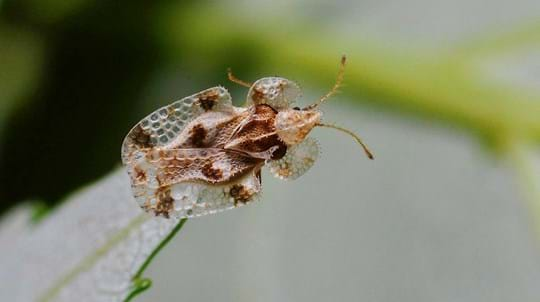
Pests and diseases
Oak Lace Bug
An insect pest that attacks oaks.

Fera Science Ltd
One of the products that Belgium is most famous for, along with chocolate and beer, is Brussels lace. However, it is also a great place to find lace bugs as I discovered during a visit last September. What are lace bugs? They are plant feeding bugs. Most species have an elaborate net or lace-like structure that covers the upper-body, hence the common name. This can only really be appreciated when the insect is viewed under a low power microscope. There are about 2000 species of lace bug worldwide, all assigned to the family Tingidae; the majority are host-specific (feeding on one type of plant) and a small number of species are highly destructive plant pests.
London plane (Platanus × acerifolia) trees line the streets and fill the parks in central Brussels. When I visited last September I could see the foliage of many trees exhibiting severe chlorosis (yellowing) and some necrosis (browning). This was consistent with feeding damage caused by the plane lace bug but where were the culprits (they were not in ‘plane’ view)?
Lace bug nymphs and adults feed in a characteristic way. They sit on the lower surface of leaves and insert their needle-like mouthparts into the leaf, sucking out cell contents just below the upper leaf surface. Therefore, feeding damage is seen on the upper surface while the insects are hidden beneath.
Lace bugs produce liquid frass (excrement) and the lower leaf surface becomes covered with black specks of dried frass together with cast nymphal skins.
Many leaves I observed in Brussels had dozens of insects on the lower surface but as soon as I touched the leaves (to photograph the insects), most of them rapidly ran or flew off.
There are two similar species of lace bug that are of concern to the UK. Both are native to North America: plane lace bug (Corythucha ciliata) feeds on Platanus and oak lace bug (C. arcuata) feeds on oak (Quercus). If searching for information on the web it is useful to know that in North America C. ciliata is commonly known as the ‘sycamore lace bug’ – a misleading name in Britain as it does not feed on sycamore (Acer pseudoplatanus). Both species lay elliptical, brown, eggs, with a lighter operculum (lid), in small groups in the angles of the main vein on the undersides of the leaf. The nymphs appear flattened, oval in shape, black and spiny. Adult bodies are almost black in colour but this is hidden beneath the cream net or lace-like structure.
They attain a length of about 4 mm; females are slightly larger than the males. Both species can have multiple generations each year and usually overwinter in the adult stage. Platanus lace bug has spread throughout most of Europe while oak lace bug has a more restricted distribution in southern and central Europe.
Oak and London plane are iconic trees for the UK. Both species of lace bug (especially the Platanus lace bug) can cause chlorosis, partial defoliation, reduction in growth and thinning of fronds. Several consecutive years of severe lace bug damage, combined with other stress factors, may even kill susceptible trees. Damage is more severe during dry weather when trees are stressed. Platanus lace bug is also reported to be a public nuisance as large numbers of the bugs land on people in parks and open-air cafes. They may also invade homes in large numbers and have been reported biting humans.
In September and October 2006 a small population of Platanus lace bug was found at a nursery in Bedfordshire. It had been accidently introduced on large Platanus trees imported from continental Europe. Fortunately the outbreak was found at an early stage and eradicated by spraying. This is why early detection is important as any measures taken can be more effective.
A related insect, Pieris lace bug Stephanitis takeyai, native to Japan, was accidently introduced in Berkshire in 1995 on Pieris plants imported from The Netherlands. Pieris lace bug has established widely in southern England and can cause severe damage, even killing individual plants.
Any suspected outbreaks of exotic lace bugs should be reported to Tree Alert.